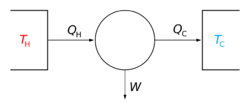Physics:Regenerative cooling
From HandWiki
(Redirected from Regenerative cycle)
| Thermodynamics |
|---|
 |
Regenerative cooling is a method of cooling gases in which compressed gas is cooled by allowing it to expand and thereby take heat from the surroundings. The cooled expanded gas then passes through a heat exchanger where it cools the incoming compressed gas.[1]
Regenerative cycles
History
In 1857, Siemens introduced the regenerative cooling concept with the Siemens cycle.[2] In 1895, William Hampson in England[3] and Carl von Linde in Germany[4] independently developed and patented the Hampson–Linde cycle to liquefy air using the Joule–Thomson expansion process and regenerative cooling.[5] On 10 May 1898, James Dewar used regenerative cooling to become the first to statically liquefy hydrogen.
See also
- Cryocooler
- Displacer
- Fluid mechanics
- Regenerative cooling (rocket)
- Regenerative heat exchanger
- Thermodynamic cycle
- Timeline of hydrogen technologies
References
- ↑ "Cryogenic microcooling Pag.25". http://www.ub.utwente.nl/webdocs/tn/1/t000001c.pdf.
- ↑ Charles William Siemens, "Improvements in refrigerating and producing ice, and in apparatus or machinery for that purpose", British patent no. 2064 (filed: July 29, 1857).
- ↑ W. Hampson, "Improvements relating to the progressive refrigerating of gases", British patent 10,165 (filed: May 23, 1895).
- ↑ Linde, Carl, "Verfahren zur Verflüssigung atmosphärischer Luft oder anderer Gase" (Method for the liquefication of atmospheric air or other gases), German patent 88,824 (filed: June 5, 1895).
- ↑ Hydrogen through the Nineteenth Century
External links
ja:潜熱#再生冷却
 |
